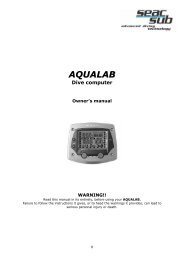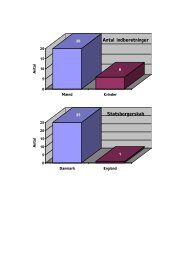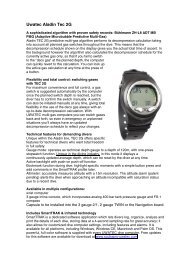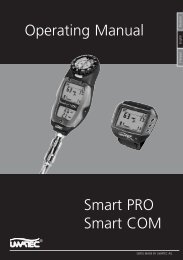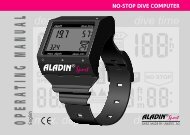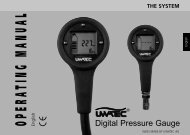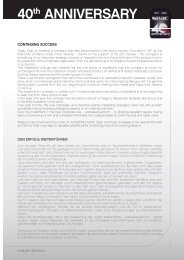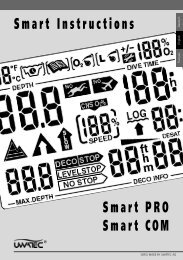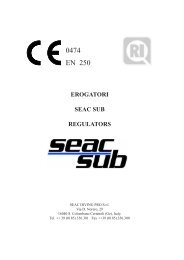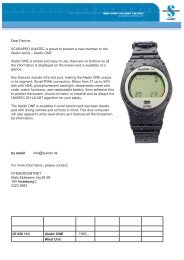Galileo Sol.pdf
Galileo Sol.pdf
Galileo Sol.pdf
- No tags were found...
Create successful ePaper yourself
Turn your PDF publications into a flip-book with our unique Google optimized e-Paper software.
3. Diving with <strong>Galileo</strong>higher there is risk of long exposureeffects, and consequently <strong>Galileo</strong> willactivate an alarm when this level ofCNS O 2 is reached. <strong>Galileo</strong> can alsowarn you when the CNS O 2 levelreaches 75% (see section 2.6.2). Notethat the CNS O 2 clock is independent ofthe value of ppO 2max set by the user.The CNS O 2 clock increases when theoxygen partial pressure is higher than0.5bar, and decreases when the oxygenpartial pressure is lower than 0.5bar. Hence,while on the surface breathing air you willalways be decreasing the CNS O 2 clock.During the dive, the depth at which 0.5baris reached for various mixes is as follows:Air:13m/43ft32%: 6m/20ft36%: 4m/13ftDepthat which ppO 2reaches 0.5bar forthree commonlyused mixes21% 13m (43ft)32% 6m (20ft)36% 4m (13ft)3.2 AlarmsCNS O 2%decreasesCNS O 2%increasesppO 20.21bar0.5bar<strong>Galileo</strong> can alert you of potentially dangeroussituations via warnings and alarms.Warnings represent situations that require thediver’s attention, but ignoring them does notrepresent an immediate risk. The detaileddescription of each warning and how it appearson the screen is presented in section 2.6.Alarms, on the other hand, can not beturned off because they represent situationsthat do require immediate action by thediver. There are six different alarms:1. Ascent rate alarm2. Exceeding a safe ppO 2/MOD3. CNS O 2 =100%4. Missed decompression stop5. RBT = 0 minutes6. Low battery during the dive WARNINGWhen in gauge mode, all warnings and allalarms are OFF aside for the low batteryalarm. NOTE:- Alarms are both visual and audible,as described in detail below.- If you are in COMPASS modewhen an alarm is triggered, <strong>Galileo</strong>will revert to the regular computerdisplay (CLASSIC, LIGHT orFULL) in order to properly displaythe message related to the alarm.- Ascent rate alarm has priority overother alarms if they are triggeredsimultaneously.- If warnings are activated whilealarms are showing, the former willshow only after the alarms haveexpired and only if they are stillapplicable at that time.3.2.1 Ascent rateAs you ascend during a dive, the pressuresurrounding you diminishes. If you ascendtoo quickly, the ensuing pressure reductioncould lead to microbubble formation. If youascend too slowly, the continued exposureto high ambient pressure means that you willcontinue loading some or all of your tissueswith nitrogen. Consequently, there is an idealascent rate that is slow enough to minimizemicrobubble formation yet fast enough tominimize the effect of continued loading onyour tissues.The pressure reduction that the body cantolerate without signifi cant microbubbleformation is higher at depth than it is in theshallows: the key factor is not the pressuredrop by itself, but rather the ratio of thepressure drop relative to the ambient pressure.This means that the ideal ascent rate at depthis higher than it is in the shallows.English43



